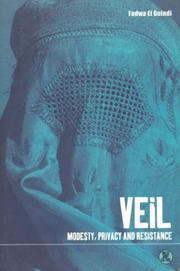| Listing 1 - 2 of 2 |
Sort by
|

ISBN: 2738473709 9782738473707 Year: 1999 Publisher: Paris: L'Harmattan,
Abstract | Keywords | Export | Availability | Bookmark
 Loading...
Loading...Choose an application
- Reference Manager
- EndNote
- RefWorks (Direct export to RefWorks)
Veils --- Women in Islam --- Women, Arab --- Voiles (Coiffures) --- Femmes dans l'Islam --- Femmes arabes --- Religious aspects --- Education --- Aspect religieux --- Muslim women --- Education (Higher) --- Sociology of culture --- Islam --- Sociology of minorities --- Religious studies --- France --- Muslim women - France --- Muslim women - Education (Higher) - France --- Migration background --- Norms --- Students --- Book --- Veil

ISBN: 1859739296 1859739245 1845208846 0585436622 Year: 1999 Publisher: Oxford Berg
Abstract | Keywords | Export | Availability | Bookmark
 Loading...
Loading...Choose an application
- Reference Manager
- EndNote
- RefWorks (Direct export to RefWorks)
Shortlisted for the Katharine Briggs Folklore Award 2000. In the 1970s, often to the consternation of parents and siblings, certain progressive young Arab women voluntarily donned the veil. The movement, which rapidly expanded and continues to gather momentum, has sparked controversy within Islamic culture, as well as reactions ranging from perplexity to outrage from those outside it. Western feminist commentators have been particularly vociferous in decrying the veil, which they glibly interpret as a concrete manifestation of patriarchal oppression. However, most Western observers fail to realize that veiling, which has a long and complex history, has been embraced by many Arab women as both an affirmation of cultural identity and a strident feminist statement. Not only does the veil de-marginalize women in society, but it also represents an expression of liberation from colonial legacies. In short, contemporary veiling is more often than not about resistance. By voluntarily removing themselves from the male gaze, these women assert their allegiance to a rich and varied tradition, and at the same time preserve their sexual identity. Beyond this, however, the veil also communicates exclusivity of rank and nuances in social status and social relations that provide telling insights into how Arab culture is constituted. Further, as the author clearly demonstrates, veiling is intimately connected with notions of the self, the body and community, as well as with the cultural construction of identity, privacy and space. This provocative book draws on extensive original fieldwork, anthropology, history and original Islamic sources to challenge the simplistic assumption that veiling is largely about modesty and seclusion, honor and shame.
Muslim women. --- Veils --- Muslim women --- Voiles (Coiffures) --- Musulmanes --- Customs and practices --- Clothing --- Coutumes et pratiques --- Costume --- Customs and practices. --- Clothing. --- Arab States --- Sociology of culture --- History --- Ethnology. Cultural anthropology --- Islam --- History of civilization --- Religious studies --- Social aspects. --- Social aspects --- Aspect social --- Arab states --- Fashion --- Norms --- Appearance --- Book --- Anthropology --- Veil
| Listing 1 - 2 of 2 |
Sort by
|

 Search
Search Feedback
Feedback About UniCat
About UniCat  Help
Help News
News